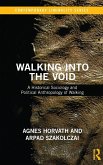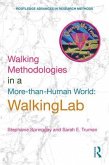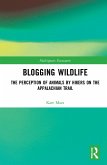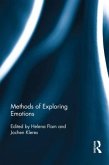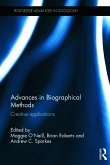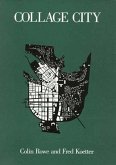- Gebundenes Buch
- Merkliste
- Auf die Merkliste
- Bewerten Bewerten
- Teilen
- Produkt teilen
- Produkterinnerung
- Produkterinnerung
This book introduces and critically explores walking as an innovative method for doing social research, showing how its sensate and kinaesthetic attributes facilitate connections with lived experiences, journeys and memories, communities and identities.
Andere Kunden interessierten sich auch für
![Walking into the Void Walking into the Void]() Arpad SzakolczaiWalking into the Void178,99 €
Arpad SzakolczaiWalking into the Void178,99 €![Walking Methodologies in a More-than-human World Walking Methodologies in a More-than-human World]() Stephanie SpringgayWalking Methodologies in a More-than-human World189,99 €
Stephanie SpringgayWalking Methodologies in a More-than-human World189,99 €![Blogging Wildlife Blogging Wildlife]() Kate MarxBlogging Wildlife168,99 €
Kate MarxBlogging Wildlife168,99 €![Walking Together in Indigenous Research Walking Together in Indigenous Research]() Walking Together in Indigenous Research42,99 €
Walking Together in Indigenous Research42,99 €![Methods of Exploring Emotions Methods of Exploring Emotions]() Methods of Exploring Emotions177,99 €
Methods of Exploring Emotions177,99 €![Advances in Biographical Methods Advances in Biographical Methods]() Advances in Biographical Methods176,99 €
Advances in Biographical Methods176,99 €![Collage City Collage City]() Colin RoweCollage City47,99 €
Colin RoweCollage City47,99 €-
-
-
This book introduces and critically explores walking as an innovative method for doing social research, showing how its sensate and kinaesthetic attributes facilitate connections with lived experiences, journeys and memories, communities and identities.
Produktdetails
- Produktdetails
- Verlag: Routledge
- Seitenzahl: 292
- Erscheinungstermin: 23. Juli 2019
- Englisch
- Abmessung: 240mm x 161mm x 20mm
- Gewicht: 605g
- ISBN-13: 9781138182479
- ISBN-10: 1138182478
- Artikelnr.: 57174596
- Herstellerkennzeichnung
- Libri GmbH
- Europaallee 1
- 36244 Bad Hersfeld
- gpsr@libri.de
- Verlag: Routledge
- Seitenzahl: 292
- Erscheinungstermin: 23. Juli 2019
- Englisch
- Abmessung: 240mm x 161mm x 20mm
- Gewicht: 605g
- ISBN-13: 9781138182479
- ISBN-10: 1138182478
- Artikelnr.: 57174596
- Herstellerkennzeichnung
- Libri GmbH
- Europaallee 1
- 36244 Bad Hersfeld
- gpsr@libri.de
Maggie O'Neill is Professor in Sociology at the University of Cork. She has a long history of doing critical theory/feminist research and conducting walking, participatory and biographical methods with communities and artists, as well as marginalised groups on topics such as sex work, migration, and participatory, creative, and arts-based methodologies. Brian Roberts taught and researched at several UK universities and was a visiting academic at institutions in a number of countries. He was closely associated with the early work of the Centre for Contemporary Cultural Studies, University of Birmingham, UK. He has written widely on biographical research, social theory, and research practice.
Introduction Part I: Theorizing/Observing/Thinking 1. Methods on the Move:
Moving Methods 2. Theorizing Walking in the Sociological Imagination -
Walking in Context 3. Walking, Art-Making and Biographical Research
Exercise One: Walking and Theorizing - Observing/Thinking Part II:
Experiencing 4. Migration, Memory and Place - Connecting with Memory and
Place in Urban Landscapes 5. Walking as Re-Formative and Transgressive:
Health, Pilgrimage, Trespass, Marching 6. Walking in the Downtown Eastside
- Experiencing the WIBM as Participatory, Visual and Ethnographic Exercise
Two: Walking, Sensing, Experiencing Part III: Imagining 7. Walking, Sex
Work, and Community: Towards a Radical Democratic and Imaginative Space for
addressing Sexual and Social Inequalities 8. The Phenomenology of Walking
in a Garden 9. Walking Artists: Critical Dialogues and Imaginaries 10.
Auto/Biographical Encounters in Time and Space - Roots and Routes Exercise
Three: Walking and Imagining - Time/Memory/Making Conclusion: The Future of
the Walking Interview as a Biographical Method Exercise Four: WIBM Exercise
- Observing, Experiencing, Imagining The Walking Interview as a
Biographical Method - Principles and Practice: A Framework
Moving Methods 2. Theorizing Walking in the Sociological Imagination -
Walking in Context 3. Walking, Art-Making and Biographical Research
Exercise One: Walking and Theorizing - Observing/Thinking Part II:
Experiencing 4. Migration, Memory and Place - Connecting with Memory and
Place in Urban Landscapes 5. Walking as Re-Formative and Transgressive:
Health, Pilgrimage, Trespass, Marching 6. Walking in the Downtown Eastside
- Experiencing the WIBM as Participatory, Visual and Ethnographic Exercise
Two: Walking, Sensing, Experiencing Part III: Imagining 7. Walking, Sex
Work, and Community: Towards a Radical Democratic and Imaginative Space for
addressing Sexual and Social Inequalities 8. The Phenomenology of Walking
in a Garden 9. Walking Artists: Critical Dialogues and Imaginaries 10.
Auto/Biographical Encounters in Time and Space - Roots and Routes Exercise
Three: Walking and Imagining - Time/Memory/Making Conclusion: The Future of
the Walking Interview as a Biographical Method Exercise Four: WIBM Exercise
- Observing, Experiencing, Imagining The Walking Interview as a
Biographical Method - Principles and Practice: A Framework
Introduction Part I: Theorizing/Observing/Thinking 1. Methods on the Move:
Moving Methods 2. Theorizing Walking in the Sociological Imagination -
Walking in Context 3. Walking, Art-Making and Biographical Research
Exercise One: Walking and Theorizing - Observing/Thinking Part II:
Experiencing 4. Migration, Memory and Place - Connecting with Memory and
Place in Urban Landscapes 5. Walking as Re-Formative and Transgressive:
Health, Pilgrimage, Trespass, Marching 6. Walking in the Downtown Eastside
- Experiencing the WIBM as Participatory, Visual and Ethnographic Exercise
Two: Walking, Sensing, Experiencing Part III: Imagining 7. Walking, Sex
Work, and Community: Towards a Radical Democratic and Imaginative Space for
addressing Sexual and Social Inequalities 8. The Phenomenology of Walking
in a Garden 9. Walking Artists: Critical Dialogues and Imaginaries 10.
Auto/Biographical Encounters in Time and Space - Roots and Routes Exercise
Three: Walking and Imagining - Time/Memory/Making Conclusion: The Future of
the Walking Interview as a Biographical Method Exercise Four: WIBM Exercise
- Observing, Experiencing, Imagining The Walking Interview as a
Biographical Method - Principles and Practice: A Framework
Moving Methods 2. Theorizing Walking in the Sociological Imagination -
Walking in Context 3. Walking, Art-Making and Biographical Research
Exercise One: Walking and Theorizing - Observing/Thinking Part II:
Experiencing 4. Migration, Memory and Place - Connecting with Memory and
Place in Urban Landscapes 5. Walking as Re-Formative and Transgressive:
Health, Pilgrimage, Trespass, Marching 6. Walking in the Downtown Eastside
- Experiencing the WIBM as Participatory, Visual and Ethnographic Exercise
Two: Walking, Sensing, Experiencing Part III: Imagining 7. Walking, Sex
Work, and Community: Towards a Radical Democratic and Imaginative Space for
addressing Sexual and Social Inequalities 8. The Phenomenology of Walking
in a Garden 9. Walking Artists: Critical Dialogues and Imaginaries 10.
Auto/Biographical Encounters in Time and Space - Roots and Routes Exercise
Three: Walking and Imagining - Time/Memory/Making Conclusion: The Future of
the Walking Interview as a Biographical Method Exercise Four: WIBM Exercise
- Observing, Experiencing, Imagining The Walking Interview as a
Biographical Method - Principles and Practice: A Framework



